§ Gal·axy \'ga-lek-sē\ Gal·ax·ies
1. From David Malin: the ancient Greek word for milk is 'gala', which is linked to the Latin 'lac' (milk) and both the words refer to the milky appearance of galaxies, including the Milky Way, itself a translation of the Latin 'via lactea'. 'Via' is still in use in English,. e.g. in 'viaduct'
2. From the Online Etymology Dictionary: c.1384, from L.L. galaxias "Milky Way," from Gk. galaxis (adj.), from gala (gen. galaktos) "milk". The technical astronomical sense emerged 1848. Fig. sense of "brilliant assembly of persons" is from 1590.
§ Contents of Chapter One
- You Should Know — Galaxy Terminology
In This Section You Should Know — Definitions from the Astronomical Science of Galaxies - Galaxies — Classification Refresher
The Visual Morphology of a Galaxy — The Hubble Sequence - When We Think of a Galaxy...
Spiral Arms, Irregular Shapes A Quick Visual of Galaxy Types - Elliptical Galaxies Form & Composition
Ellipsoidal Agglomerations of Stars with a Sparse Interstellar Medium and Minimal Star Formation - An Elliptical Galaxy Called "Peculiar"
A Sub-type of Galaxy that's generally assigned the designator "Pec" or "P." Peculiar — distinct from all others, unusal or strange. - A Gallery of Elliptical Form
From the Normal E's to the Strange P's
NGC 5128 — LEO I — Arp 102 — M60 - Imaging the Elliptical
The Hickson Compact Group of Galaxies — Arp's Catalog Of Peculiar Galaxies
HCG 92 — HCG 90 — HCG 87 — HCG 40 — M84 — Arp 107 — Arp 94 — Arp 97 — NGC 1316 - NEW! Chapter Two
Spirals — Hunting for The Perfect Galaxy
1. You Should Know — Galaxy Terminology
» Einstein Ring - an Einstein ring is the deformation of the light from a source ( such as a galaxy or star ) into a ring through gravitational lensing of the source's light by an object with an extremely large mass ( such as another galaxy, or a black hole ). This occurs when the source, lens and observer are all aligned see: Wikipedia
» Gravitational Lensing - formed when the light from a very distant, bright source ( such as a quasar ) is "bent" around a massive object ( such as a cluster of galaxies ) between the source object and the observer. The process is known as gravitational lensing, and is one of the predictions of Albert Einstein's general theory of relativity see: Wikipedia
» Morphological Type - a system that categorizes galaxies according to their apparent shape. This system was first developed by the famed astronomer Edwin Hubble Reference/Further Study: Wkipedia - Galaxy Morphology - Introduction ( Educational Lab ) - Near-Infrared Galaxy Morphology Atlas
» Solar Mass - in astronomy it is used to describe the masses of other stars and galaxies. It is equal to the mass of the Sun, 332,950 times the mass of the Earth, or 1048 times the mass of Jupiter. The solar mass can be determined from the length of the year, the distance of the Earth to the Sun (the astronomical unit - AU), and the gravitational constant G.
» Flux - the galaxy's energy output based on a size and age comparative analysis. Also: the amount of energy moving in the form of photons at a certain distance from the source per steradian per second. Used in astronomy to determine the magnitude and spectral class of a star. Also acts as a generalization of heat flux, which is equal to the radiative flux when restricted to the infrared spectrum, see Wikipedia
» Angular Size - the sizes of objects in the sky are often given in terms of their angular diameter as seen from Earth, rather than their actual sizes.
The angular diameter of Earth's orbit around the Sun, from a distance of one parsec, is 2" ( two arcseconds ) see Wikipedia.
» Radial Velocity / Redshift - is the velocity of an object in the direction of the line of sight ( i.e. its speed straight towards you, or away from you ). Radial Velocity & Redshift are "hand-in-hand" data; the light of an object with a substantial radial velocity will be subject to the Doppler effect, so the frequency of the light decreases for receding objects or redshifted and increases for approaching objects or blueshifted. The radial velocity of a star or other luminous but distant objects can be measured accurately by taking a high-resolution spectrum and comparing the measured wavelengths of known spectral lines to wavelengths from laboratory measurements. By convention, a positive radial velocity indicates the object is receding; if the sign is negative, then the object is approaching.
» Accretion is the physical process of matter being pulled from a source or stellar object into another point or object via a large gravitional field of attraction. This process is associated with, amongst others, black holes, regions of star birth and some processes of galaxy formation. In terms of galaxies and accretion see the recent study: Ongoing Galactic Accretion: Simulations and Observations of Condensed Gas in Hot Halos the Astronomical Journal, J. E. G. Peek et al 2008 ApJ 674 227-236.
» Tidal Arm As galaxies merge, small galaxies or stars may be born in the dust and gaseous debris thrown out from the collision which can often form an extension much like the arm of a galaxy. Tidal arms and debris are seen in our own stellar system as the Milky Way and two nearby galaxies, the Large and Small Magellanic Clouds continue their gravitational "tug-of-war" with each other.
» Bridge 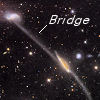 Similar to the above tidal arm, the "bridge" is stellar matter between two objects which is usually pre-collsional or the result of a near miss between the two. The resulting bridge of gas and dust created from mutual gravitational forces often creates eye-catching plumes of stellar material that can span thousands of light years as in the image at left of the peculiar galaxies Arp 295. Image: APOD Arne Henden (US Naval Observatory, Flagstaff) Image Processed by Al Kelly
Similar to the above tidal arm, the "bridge" is stellar matter between two objects which is usually pre-collsional or the result of a near miss between the two. The resulting bridge of gas and dust created from mutual gravitational forces often creates eye-catching plumes of stellar material that can span thousands of light years as in the image at left of the peculiar galaxies Arp 295. Image: APOD Arne Henden (US Naval Observatory, Flagstaff) Image Processed by Al Kelly
» M xx | NGC xxxx | ESO xxx-x | LEDA xxxxx - in addition to the usage of proper names, such as the Pinwheel or Cigar galaxies, stellar objects are usually designated with single or multiple letters and numbers from the various catalogs of stellar objects or survey types. Below are just a few examples often seen throughout this site:
» M refers to astronomical objects catalogued by Charles Messier in his "Catalogue des Nébuleuses et des Amas d'Étoiles" ( Catalogue of Nebulae and Star Clusters ), Messier at Wikipedia originally published in 1771;
» NGC refers to the well-known New General Catalogue ( NGC ) of deep sky objects in amateur astronomy. It contains 7,840 objects, known as the NGC objects. New General Catalogue at Wikipedia The NGC is one of the largest comprehensive catalogues, as it includes all types of deep space objects and is not confined to, for example, galaxies;
» ESO refers to the European Southern Observatory astronomical catalogs published and supported by fourteen countries from Europe, created in 1962, and whose official name is the European Organization for Astronomical Research in the Southern Hemisphere. The ESO is credited with many firsts in the astronomical world ESO at Wikipedia;
» LEDA refers to the Lyon-Meudon Extragalactic Database The Smithsonian/NASA Astrophysics Data System LEDA was created in 1983 at the Observatoire de Lyon.
» LINER type Active Galaxy Nucleus refers to a Low-Ionization Nuclear Emission-line Region for a type of active galaxy. "LINERs are characterized by extremely bright, starlike central nuclei...and are low-luminosity cousins of Seyfert galaxies. While normal ( spiral ) galaxies radiate primarily at optical and infrared wavelengths, active galaxies tend to have significant x-ray and synchrotron radio emission. The source of x-rays is likely to be an active galactic nucleus ( AGN )." see Multiwavelength Astronomy at the Cool Cosmos website. This site also offers some very nice classroom based labs and experiements -- highly recommended.
» Seyfert 2 Galaxy is a class of galaxies with nuclei that produce spectral line emission from highly ionized gas.
» Also see: Table of all Messier objects Poster and the Listing of Stellar Catalogs at Wikipedia
Please note that this list is by no means exhaustive and neither is it intended to be. There are many fine astronomy websites that are dedicated to astronomical terms and defintions: Encyclopedia of Astronomy and Astrophysics from Nature Publishing Group and Institute of Physics Publishing — The Internet Encyclopedia of Science from astronomer/author David Darling — Wikipedia the free worldwide user contributed referencec source. The above terms are those that the reader will encounter throughout this section and therefore, should be familiar with.
2. Galaxies — Classification Refresher
3. When We Think of a Galaxy...
Bibliography — Additional Resources
- Galaxy Classification © 2000 by William C. Keel, from Bill Keel's Galaxies Course website
- Edwin Hubble 1889-1953 The Journal of the Royal Astronomical Society of Canada, Vol. 83, No.6 December 1989 Whole No. 621
- How did galaxies form? From the NASA website, Origins Education Forum: FAQs
- Image of the Antennae from the APOD website. Quote From the Hubble Site News Release, Hubble Reveals Stellar Fireworks Accompanying Galaxy Collisions
- Quote From the Chandra Press Room, Chandra Locates Mother Lode of Planetary Ore in Colliding Galaxies
- The Milky Way is Bigger than First Believed Article from the Shouting in Digital website
- Sagittarius: Observing the Constellation of the Archer Article by Kelly Whitt Aug 10, 2007
- The Hubble Ultra Deep Field Image & Text. HubbleSite - NewsCenter - Hubble's Deepest View Ever of the Universe Unveils Earliest Galaxies (03/09/2004) - Introduction
- The Hubble Ultra Deep Field Steven V. W. Beckwith et al 2006 The Astronomical Journal 132 1729-1755, Published 2006 September, 19
- IDENTIKIT 1: A MODELING TOOL FOR INTERACTING DISK GALAXIES Joshua E. Barnes et al 2009 The Astronomical Journal 137 3071-3090, Published 2009, January 13. Linked file is in .pdf format.
- Image and text from APOD page posted on 2008, February 24
- Amazing Space: Tools- Hubble Space Telescope This is the Formal Education Group of the Space Telescope Science Institute's Office of Public Outreach and educational site for the Hubble telescope
- Galaxy Dynamics Computer Simulation "The paper considers a mathematical model of the behavior of an assembly of N stars. " Dmitry Abrosimov, Mon 14th Apr 2003. From the ©1997-2009 OSNews LLC. website.
- The formation of disk galaxies in computer simulations, by Lucio Mayer Fabio Governato & Tobias Kaufmann, arXiv:0801.3845v1 Fri, 25 Jan 2008
Additional Resources










 A galaxy's morphological classification is a system used in astronomy to divide galaxies into similar groups based on their visual appearance. Though there existed a system for doing so prior to 1920, the most widely used scheme today is the famous Hubble tuning fork sequence, devised by Edwin Hubble and later expanded by Gérard de Vaucouleurs and Allan Sandage. This classification system derives it's name from the obvious layout of the visual chart as seen at right. Hubble was not the only astronomer to base galaxy classification on visual or empirical grounds. In 1966, Halton Arp compiled a catalog of peculilar galaxies and based the arrangement of over 300 galaxies on a system of visual composition. Generally speaking, the reason for such a less ridgid scientific standard was due mostly to the fact that in the 1920's galaxies were only just beginning to receive any degree of scientific analysis, a situation that existed through the 1960's until further surveys and newer technological instruments were able to penetrate the mysteries and composition of galaxies as well as resolving the visual structures of these distant objects. At left is a diagram of Hubbles "'Tuning Fork" Diagram for Galaxy Classification Credit:
A galaxy's morphological classification is a system used in astronomy to divide galaxies into similar groups based on their visual appearance. Though there existed a system for doing so prior to 1920, the most widely used scheme today is the famous Hubble tuning fork sequence, devised by Edwin Hubble and later expanded by Gérard de Vaucouleurs and Allan Sandage. This classification system derives it's name from the obvious layout of the visual chart as seen at right. Hubble was not the only astronomer to base galaxy classification on visual or empirical grounds. In 1966, Halton Arp compiled a catalog of peculilar galaxies and based the arrangement of over 300 galaxies on a system of visual composition. Generally speaking, the reason for such a less ridgid scientific standard was due mostly to the fact that in the 1920's galaxies were only just beginning to receive any degree of scientific analysis, a situation that existed through the 1960's until further surveys and newer technological instruments were able to penetrate the mysteries and composition of galaxies as well as resolving the visual structures of these distant objects. At left is a diagram of Hubbles "'Tuning Fork" Diagram for Galaxy Classification Credit:  The Hubble classification scheme or tuning fork diagram is the prime galaxy classification tool still in use today and at right is a more modern version of the diagram using images of the galaxy types themselves. Again, it continues to provide for the categorization of galaxies through their phyical appearence with changes and additions to the original scheme a result of the nature of the astrophysics inherent when classifying galaxies. In the end, the basic system follows a standard pattern for galaxy types:
The Hubble classification scheme or tuning fork diagram is the prime galaxy classification tool still in use today and at right is a more modern version of the diagram using images of the galaxy types themselves. Again, it continues to provide for the categorization of galaxies through their phyical appearence with changes and additions to the original scheme a result of the nature of the astrophysics inherent when classifying galaxies. In the end, the basic system follows a standard pattern for galaxy types: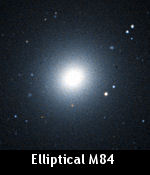
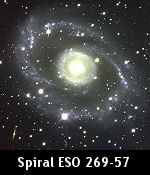
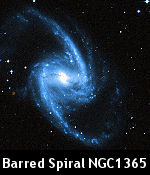
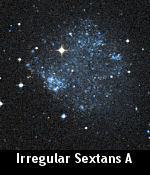
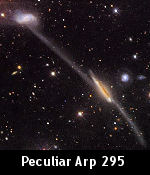
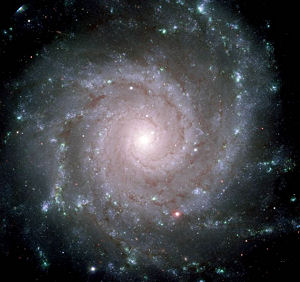
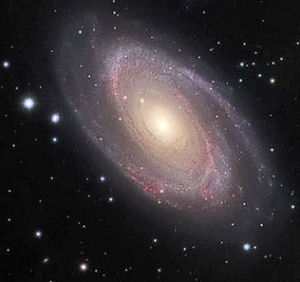












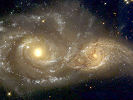
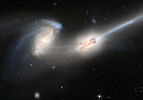 When galaxies collide the general result is that they merge into one large galaxy like NGC 2207 and IC 2163, seen at left, or they "interact" with one another, continuing on their way, reshaping their physical geometry to one extent or another due to gravitional effects, perhaps meeting again billions of years later like NGC 4676, seen at right. Recent scientific research has discovered many important facts regarding the formation of galaxies and stellar populations. Astronomers studying the Hubble Deep Field and Hubble Ultra Deep Field images saw that early galaxies were more often than not involved in frequent collisions and interactions, noting the unusual and distored shapes of galaxies seen in the images.
When galaxies collide the general result is that they merge into one large galaxy like NGC 2207 and IC 2163, seen at left, or they "interact" with one another, continuing on their way, reshaping their physical geometry to one extent or another due to gravitional effects, perhaps meeting again billions of years later like NGC 4676, seen at right. Recent scientific research has discovered many important facts regarding the formation of galaxies and stellar populations. Astronomers studying the Hubble Deep Field and Hubble Ultra Deep Field images saw that early galaxies were more often than not involved in frequent collisions and interactions, noting the unusual and distored shapes of galaxies seen in the images.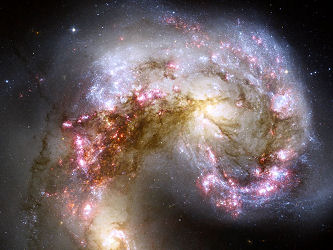 "Earlier Hubble pictures show that nearly a third of very distant galaxies, which existed early in the history of the universe, appear to be interacting galaxies, like the Antennae. In particular, the Hubble Deep Field (a "long-exposure" image from Hubble looking at galaxies far back into time), uncovered a plethora of odd-shaped, disrupted-looking galaxies. They offer direct visual evidence that galaxy collisions were more the rule than the exception in the early days of the universe." [3] "When galaxies collide, direct hits between stars are extremely rare, but collisions between huge gas clouds in the galaxies can trigger a stellar baby boom. The most massive of these stars race through their evolution in a few million years and explode as supernovas. Heavy elements manufactured inside these
"Earlier Hubble pictures show that nearly a third of very distant galaxies, which existed early in the history of the universe, appear to be interacting galaxies, like the Antennae. In particular, the Hubble Deep Field (a "long-exposure" image from Hubble looking at galaxies far back into time), uncovered a plethora of odd-shaped, disrupted-looking galaxies. They offer direct visual evidence that galaxy collisions were more the rule than the exception in the early days of the universe." [3] "When galaxies collide, direct hits between stars are extremely rare, but collisions between huge gas clouds in the galaxies can trigger a stellar baby boom. The most massive of these stars race through their evolution in a few million years and explode as supernovas. Heavy elements manufactured inside these 
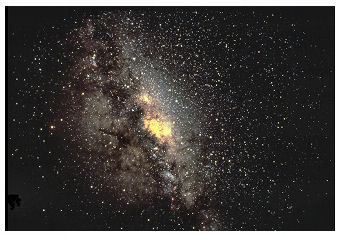
 "The Hubble Law states that the recessional velocity of a distant galaxy is proportional to its distance from us. The recessional velocity of a galaxy is measured by examining the Doppler shift of lines in the spectrum of light from the galaxy. The distance to the galaxy is more difficult to measure, but can be estimated from its apparent angular size or by the brightness of objects in it." —
"The Hubble Law states that the recessional velocity of a distant galaxy is proportional to its distance from us. The recessional velocity of a galaxy is measured by examining the Doppler shift of lines in the spectrum of light from the galaxy. The distance to the galaxy is more difficult to measure, but can be estimated from its apparent angular size or by the brightness of objects in it." —  If you took your camera into space, pointing it at the darkest most uninteresting area you could find and held the shutter open for an exposure time of over 270 hours, know what you would you get? Easy, the Hubble Ultra Deep Field image at right. "The snapshot includes galaxies of various ages, sizes, shapes, and colors. The smallest, reddest galaxies, about 100, may be among the most distant known, existing when the universe was just 800 million years old. The nearest galaxies - the larger, brighter, well-defined spirals and ellipticals - thrived about 1 billion years ago, when the cosmos was 13 billion years old...[i]n ground-based photographs, the patch of sky in which the galaxies reside (just one-tenth the diameter of the full Moon) is largely empty. Located in the constellation Fornax, the
If you took your camera into space, pointing it at the darkest most uninteresting area you could find and held the shutter open for an exposure time of over 270 hours, know what you would you get? Easy, the Hubble Ultra Deep Field image at right. "The snapshot includes galaxies of various ages, sizes, shapes, and colors. The smallest, reddest galaxies, about 100, may be among the most distant known, existing when the universe was just 800 million years old. The nearest galaxies - the larger, brighter, well-defined spirals and ellipticals - thrived about 1 billion years ago, when the cosmos was 13 billion years old...[i]n ground-based photographs, the patch of sky in which the galaxies reside (just one-tenth the diameter of the full Moon) is largely empty. Located in the constellation Fornax, the  The image at right is from Joshua E. Barnes & John E. Hibbard's site
The image at right is from Joshua E. Barnes & John E. Hibbard's site  "By combining test-particle and self-consistent techniques, we have developed a method to rapidly explore the parameter space of galactic encounters. Our method, implemented in an interactive graphics program. This software is available at
"By combining test-particle and self-consistent techniques, we have developed a method to rapidly explore the parameter space of galactic encounters. Our method, implemented in an interactive graphics program. This software is available at  "These two mighty galaxies are pulling each other apart. Known as " The Mice" because they have such long tails, each spiral galaxy has likely already passed through the other. They will probably collide again and again until they coalesce. The long tails are created by the relative difference between gravitational pulls on the near and far parts of each galaxy. Because the distances are so large, the cosmic interaction takes place in slow motion -- over hundreds of millions of years. NGC 4676 lies about 300 million light-years away toward the constellation of Bernice's Hair (Coma Berenices) and are likely members of the Coma Cluster of Galaxies. The above picture was taken with the Hubble Space Telescope's Advanced Camera for Surveys which is more sensitive and images a larger field than previous Hubble cameras. The camera's increased sensitivity has imaged, serendipitously, galaxies far in the distance scattered about the frame." Credit: ACS Science & Engineering Team, Hubble Space Telescope, NASA [11]
"These two mighty galaxies are pulling each other apart. Known as " The Mice" because they have such long tails, each spiral galaxy has likely already passed through the other. They will probably collide again and again until they coalesce. The long tails are created by the relative difference between gravitational pulls on the near and far parts of each galaxy. Because the distances are so large, the cosmic interaction takes place in slow motion -- over hundreds of millions of years. NGC 4676 lies about 300 million light-years away toward the constellation of Bernice's Hair (Coma Berenices) and are likely members of the Coma Cluster of Galaxies. The above picture was taken with the Hubble Space Telescope's Advanced Camera for Surveys which is more sensitive and images a larger field than previous Hubble cameras. The camera's increased sensitivity has imaged, serendipitously, galaxies far in the distance scattered about the frame." Credit: ACS Science & Engineering Team, Hubble Space Telescope, NASA [11]